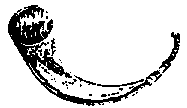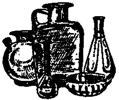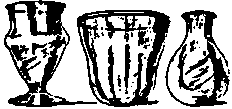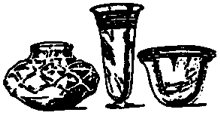 The Dark Age Table:
The Dark Age Table:
Drink Containers
This is the first in a series of articles on tableware, tables and dining practices in early times.
One of the first things that comes to mind when most people think about the period referred to as the 'Dark Ages' is a whole bunch of guys sitting around the mead hall and passing a horn overflowing with mead or some other alcoholic beverage. Horns for drinking were used by various cultures, since they formed a ready made, liquid tight container. They came in various sizes, from the large ones made to be passed around the hall to the 'one man' size.
Most were 6 to 8 ounces in capacity and were meant to be drained in one draught. They were refilled by servants or by the lady of the hall from buckets placed on the tables or pitchers.
Horns are a lot easier to come by for city dwellers since Tandy Leather started carrying them for the Buck skinners.
You can pick up a good horn for around $4. You can get an even better deal by buying one that has already been partially polished, saving yourself a lot of work for an extra $2 or so.
Once you have your horn, you will need to clean and scrape both the outside and inside. Even if you have purchased the pre-scraped horn, you will still need to do a little work on it. You can scrape the horn with a sharp knife blade, a single-edged razor blade or a sharp piece of glass. Always scrape with the grain of the horn. You will save yourself a lot of grief if you do this outside, since the smell can be memorable. Once that is finished, sand the horn with sandpaper, beginning with medium grade and progressing to fine. Again, you will want to work with the grain. Final finishing is done with very fine ('0000') steel wool, then buff the outside with sueded leather impregnated with white jeweler's rouge.
Horn is not a good container for hot drinks unless you like to taste of burnt fingernails. To finish the inside of the horn and prevent the flavor from 'adding' to whatever you are drinking you can coat the inside with polyurethane or more in keeping with the time, beeswax.
You can add decorative bands of pewter or brass and if you have access to casting equipment you could cast a terminal for the end.


 But horns weren't the only containers used. Romans were expert glass makers and carried their craft all over their domain. Native glass makers picked up the technique and were soon turning out glass replicas of drinking horns and other containers for drink. and Roman glassmakers were quick to see the possibility of making a sesterce or two by selling specialized glassware to those' barbarians' to the north. Some .of the glasses looked like modern drink glasses with painted on decorations. Certainly the most spectacular was the 'clawed beaker' which was mold blown with hollow claws around the edges that filled with drink when the glass was filled.
But horns weren't the only containers used. Romans were expert glass makers and carried their craft all over their domain. Native glass makers picked up the technique and were soon turning out glass replicas of drinking horns and other containers for drink. and Roman glassmakers were quick to see the possibility of making a sesterce or two by selling specialized glassware to those' barbarians' to the north. Some .of the glasses looked like modern drink glasses with painted on decorations. Certainly the most spectacular was the 'clawed beaker' which was mold blown with hollow claws around the edges that filled with drink when the glass was filled.



 When looking for glassware at the flea market or yard sale, keep in mind the shapes shown in this article. Also keep in mind that early glass was not clear due to impurities. It was generally a tint of amber, blue or green.
For lack of the above, you can use a wooden bowl and feel secure that you are perfectly period. You can decorate your bowl by using wood burning or painted decorations.
Illustrations:
When looking for glassware at the flea market or yard sale, keep in mind the shapes shown in this article. Also keep in mind that early glass was not clear due to impurities. It was generally a tint of amber, blue or green.
For lack of the above, you can use a wooden bowl and feel secure that you are perfectly period. You can decorate your bowl by using wood burning or painted decorations.
Illustrations:
Quennell, Marjorie and C.H.B. Everyday Life in Roman and Anglo-Saxon Times. Putnam 1955.
Everyday Life in the New Stone, Bronze and Early Iron
Age. Batsford, 1945.

Back to Early Period #1 |
Back to Early Period Index |
Back to PastTimes



 The Dark Age Table:
The Dark Age Table:





 When looking for glassware at the flea market or yard sale, keep in mind the shapes shown in this article. Also keep in mind that early glass was not clear due to impurities. It was generally a tint of amber, blue or green.
For lack of the above, you can use a wooden bowl and feel secure that you are perfectly period. You can decorate your bowl by using wood burning or painted decorations.
Illustrations:
When looking for glassware at the flea market or yard sale, keep in mind the shapes shown in this article. Also keep in mind that early glass was not clear due to impurities. It was generally a tint of amber, blue or green.
For lack of the above, you can use a wooden bowl and feel secure that you are perfectly period. You can decorate your bowl by using wood burning or painted decorations.
Illustrations: